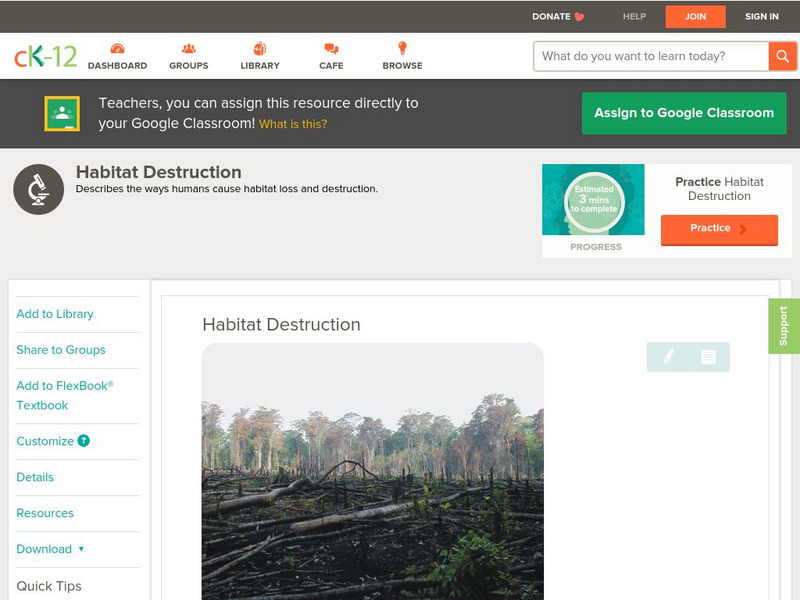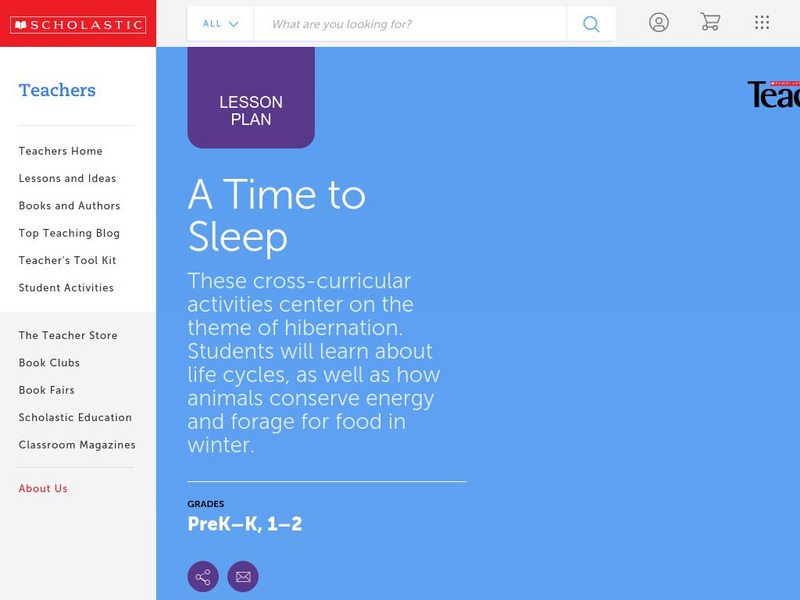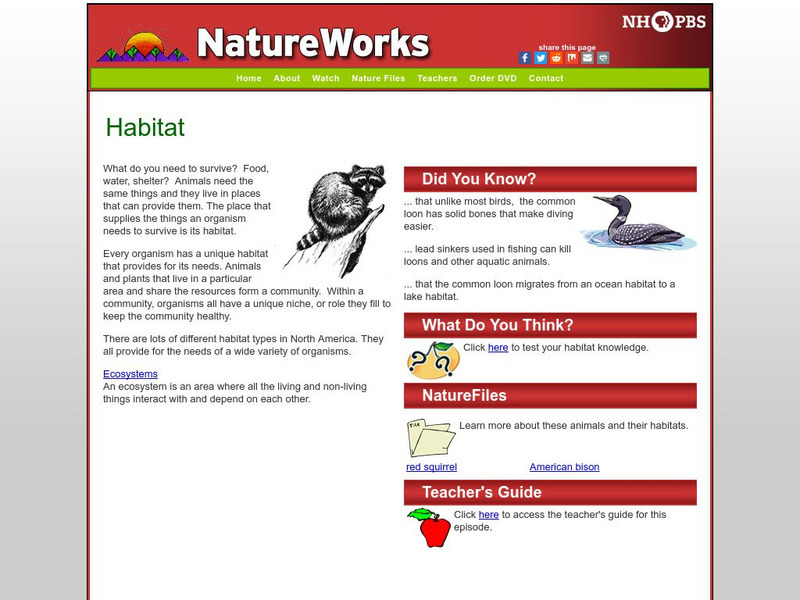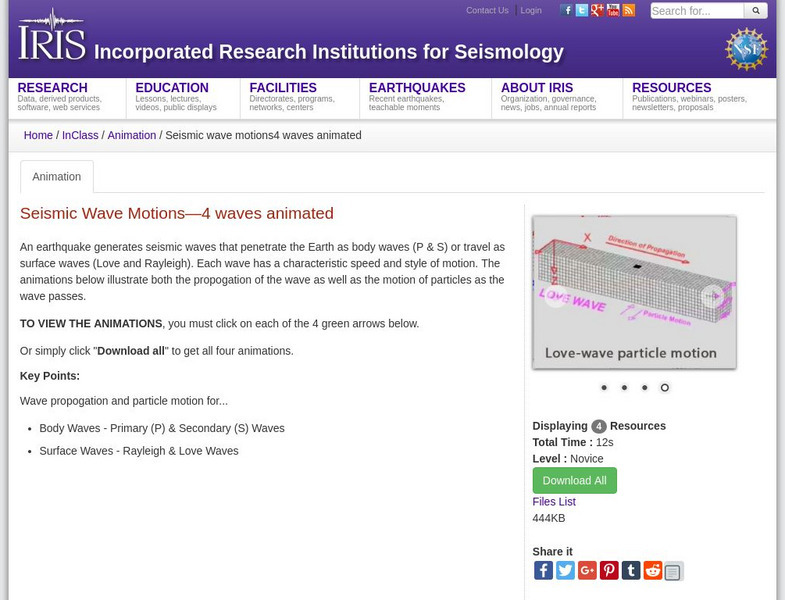Hi, what do you want to do?
CK-12 Foundation
Ck 12: Life Science: Habitat Destruction
[Free Registration/Login may be required to access all resource tools.] From a human point of view, a habitat is where you live, go to school, and go to have fun. Your habitat can be altered, and you can easily adapt. Most people live in...
Sheppard Software
Sheppard Software: Animal Profiles: Spiders
In-depth description of a spider, including its behavior, appearance, reproduction, and classification.
Encyclopedia of Earth
Encyclopedia of Earth: Noise Pollution
Explains what noise pollution is, sources, the effects of noise propagation, the impact on health and on human and animal behaviors, strategies for reducing the effects of noise, and standards in place for regulating noise pollution....
Other
Elephant Voices: Ele Quiz
Three interactive quizzes on the topics of elephant families, getures, and vocal communication. After each ten-question quiz, the correct answers are shown for review.
Society for Science and the Public
Science News for Students: Wet Dog Physics
Describes the physics behind animals' ability to dry themselves by shaking to remove water.
Alabama Learning Exchange
Alex: Importance of Fur for Animals
This is a lesson to teach students how to read a thermometer and gain an understanding of why fur is important for some animals' survival.
Scholastic
Scholastic Instructor: Hibernation "A Time to Sleep"
This site is filled with creative and educational activities for your unit on hibernation. These activities include hibernation clocks, KWL chart, hibernation mural and more.
PBS
Pbs Learning Media: Nature: Cloud Age Four
In this short Nature video, experience the environment of Cloud, a four-year old horse living in the wild. This is one in a series of three videos about Cloud. [2:23]
Regents of the University of Michigan
Animal Diversity Web: Ross Seal
A complete site that delves into geographic location, habitat, physical description, reproduction, diet, predation, economic importance (positive/negative), and conservation status.
Regents of the University of Michigan
Animal Diversity Web: Spotted Seal
A complete site that delves into geographic range, habitat, physical description, reproduction, lifespan, diet, predation, economic importance (positive/negative), and conservation status.
Environmental Education for Kids
Eek!: Teacher Resources: "Deer Talk" Activity
In this activity, students will learn to recognize how deer use non-verbal communication for mutual protection and interaction within a group and the importance of this language to the survival of the group.
PBS
Nh Pbs: Nature Works: Habitat
What do you need to survive? Food, water, shelter? Animals need the same things and they live in places that can provide them. This informative site looks at the characteristics, range, habitat, food, reproduction and behavior of the red...
PBS
Pbs Learning Media: Wild Kratts: All About Lizards Lesson Plan
Students explore the diversity of lizards in terms of characteristics, behavior, and habitat. Activities feature five species of lizards and their special body structures needed for survival.
Smithsonian Institution
National Museum of Natural History: Zoo Labs
Five inquiry-based investigations designed for the observation of primates in a zoo setting. The labs ask guiding questions and list notable primate behaviors.
PBS
Pbs: Nature: What Females Want, Wildlife and Sexual Selection
This two-part video series explores how females and males relate to each other in the animal kingdom. It shows how the strategies that males and females use to attract each other impact on the evolution of a species.
PBS
Pbs Learning Media: The Structure of Metal
In this interactive activity from the NOVA Web site, animations explain different aspects of the properties of metal.
Scholastic
Scholastic: Ocean Life
Learn about leatherback turtles and dusky dolphins with the Earthwatch research teams in Costa Rica and New Zealand. Choose which animal you would like to learn more about then read field reports, meet a researcher, become a researcher...
PBS
Pbs Learning Media: Bee Navigation
This video segment from NOVA: "The Mystery of Animal Pathfinders" explores honeybee communication and navigation. [4:45]
Science Buddies
Science Buddies: The Cat's Meow: Designing an Enrichment Toy
A great Science Fair project that involves analyzing your cat's behavior and designing toys that will be stimulating both physically and mentally. The Science Buddies project ideas are set up consistently beginning with an abstract,...
PBS
Pbs Learning Media: Brain Break I See Animals Lesson Plan
In this interactive instructional activity, young scholars act out animal movements for a short brain break.
Incorporated Research Institutions for Seismology
Iris: Seismic Wave Motions
Four animations showing the movements of surface waves and body waves that are created by earthquakes. Includes P, S, Rayleigh, and Love waves.
Online Learning Haven
Adaptations: Penguins
An interesting look at the structural and behavioral adaptations of the penguin. Neat penguin facts are included at the end of the site.
Online Learning Haven
Adaptations: Sea Turtles
An interesting that examines the structural and behavioral adaptations of the sea turtle. The problems of survival faced by the hatchlings is also delved into in this site.
Online Learning Haven
Online Learning Haven: Animals and Adaptation
This general site defines adaptation and sites examples of some of the best examples of adaptation found in the animal world. Related articles are found at the bottom of this site.
Other popular searches
- Animal Behavior Experiments
- Wild Animal Behavior
- Animal Behavior in Termites
- Animal Behavior of Fish
- Domestic Animal Behavior
- Animal Behavior Lesson Plans
- Biology Animal Behavior
- Animal Behavior Labs
- Animal Behavior Lab Betta
- Dance and Animal Behaviors
- Animal Behaviors Betta
- Innate Behavior Animal




















